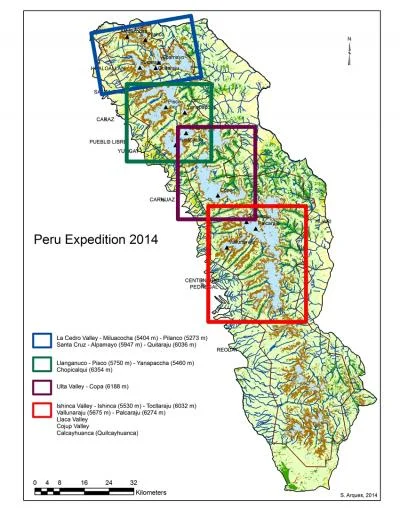Working with local stakeholders including ski areas, the Mountaineers local branches, tribes, and Western Washington University students, we are ramping up our snow sampling in the North Cascades. Glacial retreat is accelerating at temperature rise rapidly and this will have extreme consquences for Pacific Northwest urban and agricultural areas. We are creating a network of repeat sampling sites so we can track snow contaminants and glacial health over time. We are seeking partners, volunteers, and funding to help develop this program.
Effects of cattle grazing on soil nitrogen dynamics in high-elevation grasslands
Impacts of grazing and climate variability on high-elevation ecosystems
Tropical high altitude ecosystems are particularly vulnerable to the combined effects of land degradation and climate change. Mountain ecosystems globally have been extensively altered through deforestation, burning, and grazing of livestock. We are testing how native grasslands respond to reduced grazing pressure and how these responses vary across an altitudinal gradient.
Controls on nitrogen in mountainous tropical forests
Climate change and land use in Sagarmatha National Park, Nepal
Flora of Huascaran National Park and the Cordillera Blanca
In conjunction with our ground reference data research, we have collected several thousand images of plants and are identifying them in cooperation with numerous Peruvian botanists and other experts. We will choose the best images of the most representative species in the Cordillera and print a field guide that can be used by researchers and visitors to the park.
Changes in the fire regimes of the Cordillera Blanca, Peru
In Huascarán National Park, Peru, grazing and anthropogenic burning have been interacting for decades with natural ignitions and climate change to reconfigure the fire regime of the vegetative communities. Local resource managers are very concerned about the impacts of anthropogenic fires in the Park because they potentially disrupt ecological processes as well as tourism.
Differentiating climatic and anthropogenic alpine land cover change drivers over the past forty years in the Cordillera Blanca, Peru
This project examines land cover/land use changes for the past forty years in Huascaran National Park and the adjacent communal areas. There is a wealth of satellite imagery available for the Cordillera Blanca, but it needs to be verified on the ground. We visit multiple valleys and peaks to collect information on the surface characteristics including slope, aspect, soils, disturbances, fire evidence, grazing impacts, insect damage, vegetation species, vegetation health, and other vegetation information.
Water quality during rapid glacier loss
Water is an increasingly valuable and scarce resource due to global population growth, local anthropogenic activity and climate change. Many populations that rely on threatened water sources are at high risk of their supply being reduced both in quality and quantity. In the Ancash region of Peru, a large percentage of the population relies on water coming directly from the Cordillera Blanca mountain range, which is home to the highest density of tropical glaciers globally.
Black carbon and light absorbing particles on glaciers
Glaciers in the tropical Andes have been melting at an alarming rate since the 1950s. Light absorbing particles on glacier surfaces may have been contributing to increases in melt rates. The goal of the black carbon research is to determine the types and amounts of light absorbing particles make it into the snowpack.
Monitoring arthropod diversity in high-elevation ecosystems
Arthropods are among the most diverse and abundant group of animals found in tropical forests. Arthropods that live in litter and soil provide a number of ecosystem services such as maintenance of soil structure and nutrient cycling. Despite the key ecological roles of these organisms, very little is known about arthropods communities in high elevation tropical ecosystems.












